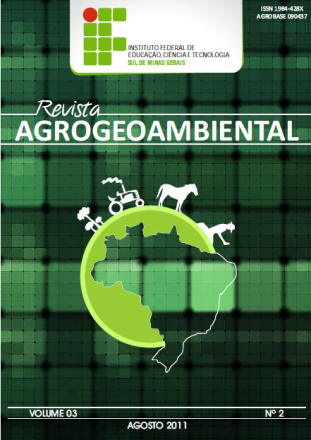Eficiência de diferentes tipos de herbicidas associados ao glyphosate no controle da commelina benghalensis
Revista Agrogeoambiental
Eficiência de diferentes tipos de herbicidas associados ao glyphosate no controle da commelina benghalensis
Autor Correspondente: Thiago Barbosa Gonçalves Silva | [email protected]
Palavras-chave: Coffee arabica. Plantas daninhas. Herbicidas. Trapoeraba.
Resumos Cadastrados
Resumo Português:
A trapoeraba (Commelina benghalensis) é uma planta daninha resistente a alguns princÃpios ativos e uma alternativa para o controle é o uso de misturas de mais de um ingrediente ativo, potencializando a ação destes sobre as plantas daninhas. Assim, este trabalho teve por objetivo avaliar o efeito de diferentes herbicidas associados ao Glyphosate e o Glyphosate isoladamente no controle da C. benghalensis em cafeeiros em produção. O experimento foi conduzido no Instituto Federal de Educação, Ciência e Tecnologia do Sul de Minas Gerais, campus Muzambinho, em uma lavoura de café cv. Rubi em produção, em delineamento de blocos casualizados (DBC) com cinco tratamentos e quatro repetições, sendo os tratamentos constituÃdos de Glyphosate (1.440g de i.a.), Glyphosate + Metsulfurom Metilico (1.440g + 6g de i.a.), Glyphosate + Carfentrazona Etilica (1.440g + 50g de i.a.), Glyphosate + Flumioxazina (1.400g + 50g de i.a.), todos com 0,5% (% v v) de óleo mineral e testemunha, totalizando 20 parcelas. Foi avaliado, através de uma escala de notas, o nÃvel de controle aos 0, 1, 3, 6, 9, 12 e 15 dias após a aplicação (DAA), e os resultados foram transformados em (x+1)0,5. Os tratamentos Glyphosate + Flumioxazina e Glyfosate + Carfentrazona EtÃlica foram os que apresentaram os melhores nÃveis de controle.
Resumo Inglês:
The trapoeraba (Commelina benghalensis) is a weed resistant to active principles, one alternative
is the use of mixtures of active ingredients in tank mixture enhances the activity on these weeds. This work aimed to evaluate the effect of different herbicides associated with Glyphosate and Glyphosate alone in the control of C. benghalensis in coffee production. The experiment was conducted
at the Federal Institute of Education, Science and Technology Southern Minas Gerais, câampus Muzambinho in a coffee crop cv. Ruby in production, in a randomized block design (RBD) in plots
subdivided in time with five treatments and four replications, with treatments consisting of Glyphosate
(1.440g i.a. ha-1), Glyphosate + Metsulfurom Methyl (6g + 1.440g i.a. ha-1), Glyphosate +
Carfentrazone Ethyl (50g + 1.440g i.a. ha-1), Glyphosate + Flumioxazine (1.400g + 50g i.a. ha-1)
each with 0.5 (% v v) mineral oil and control, totaling 20 plots. Were evaluated using a scale, the
control level at 0, 1, 3, 6, 9, 12 and 15 days after application (DAA), and the results were converted
to (x +1) 0,5 . Treatments Glyphosate and Flumioxazina + Carfentrazone Ethanol Glyphosate were those with the highest levels of control.

